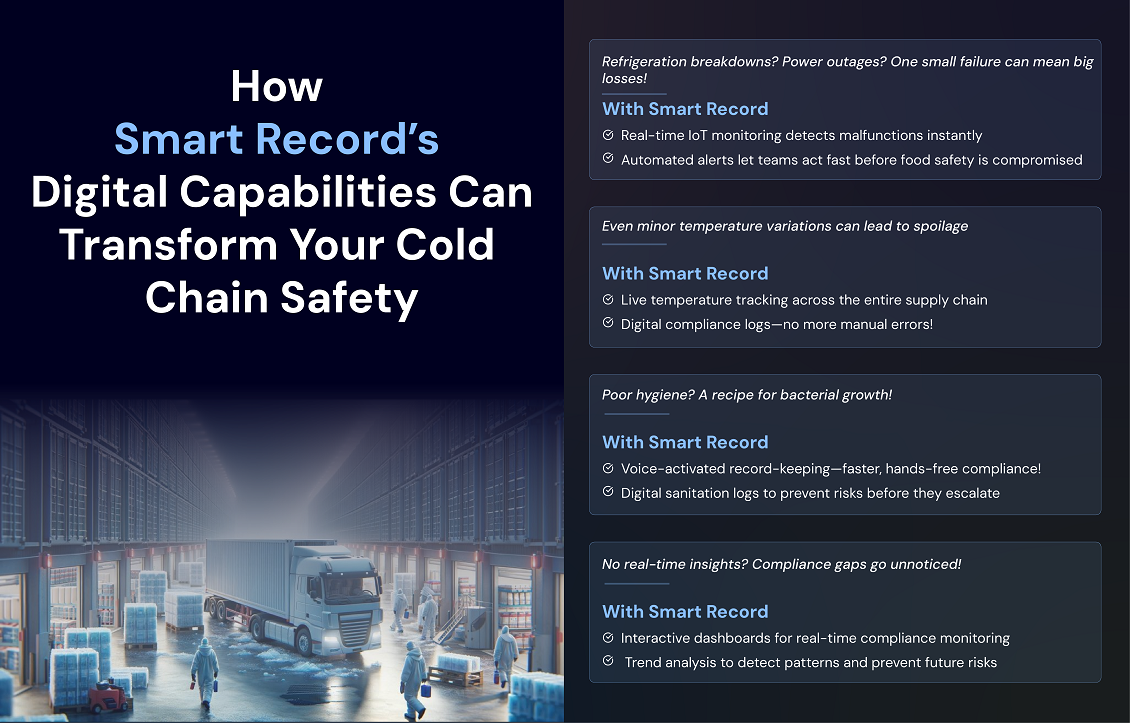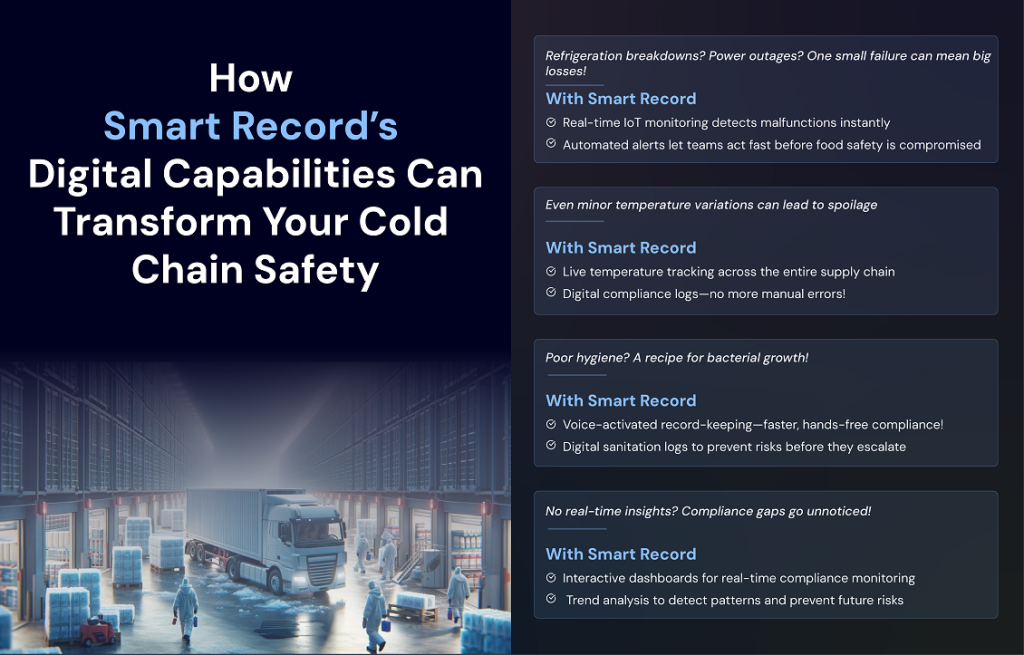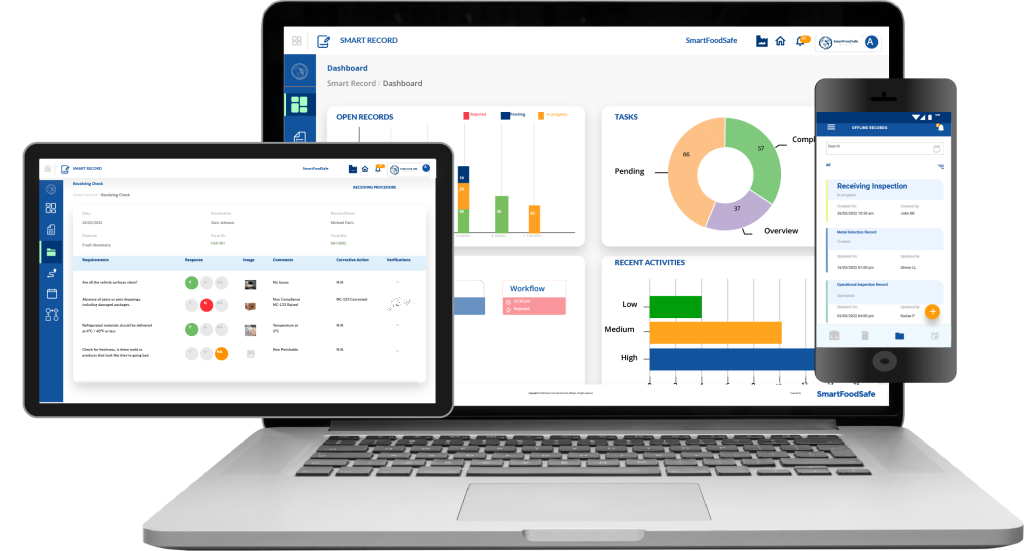
Is one temperature fluctuation all it takes to break your cold chain? Not-so-shockingly, yes.
It simply underlines the significance of maintaining food safety throughout the cold chain as any temperature fluctuations, human error, and outdated record-keeping systems can lead to significant losses due to spoilage, decreased shelf life, and potential foodborne illnesses.
The modern food supply chain has changed completely in the way we access perishable products, allowing seasonal and temperature-sensitive foods to be available year-round. However, ensuring the cold chain remains intact can be a challenging endeavor. Hence, exploring and undertaking the best practices for managing today’s cold chain food safety efficiently is key for the stakeholders in the long run.
Challenges of Traditional Cold Chain Management
Traditional cold chain management relies heavily on manual processes, such as handwritten logs, spreadsheets, and periodic temperature checks. While these methods have been the industry standard for decades, they are fraught with challenges that compromise the integrity of temperature-sensitive products:
-
Equipment Failures Leading to Temperature Deviations
Cold chain logistics depend on refrigeration units, freezers, and temperature-controlled transport. However, power outages, coolant failures, and system malfunctions can cause temperature fluctuations, leading to product spoilage. Since manual monitoring may not detect these issues in real-time, businesses often suffer financial losses before corrective action can be taken.
-
Inconsistent Temperature Control Across the Supply Chain
Perishable goods such as fresh produce, seafood, and pharmaceuticals require stable temperature conditions. However, factors like transit delays, inefficient cooling mechanisms, and changing environmental conditions can cause fluctuations. Without automated monitoring systems, these temperature variations often go unnoticed until product quality is compromised.
-
Microbial Contamination Due to Poor Maintenance
A lack of real-time temperature control and inadequate sanitation in cold storage facilities increase the risk of microbial growth. Traditional cold chain systems often rely on periodic inspections, which may not detect contamination early enough to prevent food safety or pharmaceutical compliance issues.
-
Human Errors in Cold Chain Handling and Documentation
Traditional cold chain management is highly dependent on human intervention, which increases the likelihood of errors in handling, record-keeping, and logistics coordination. Inaccurate documentation, improper packaging, or failure to maintain optimal storage conditions can lead to compliance violations and product losses.
-
Product Damage from Poor Storage and Transport Practices
Improper packaging and stacking in storage units, and inconsistent temperature control during transit can lead to damaged or compromised goods. Manual tracking methods make it difficult to detect issues in real time, increasing the risk of financial loss and reputational damage.
-
Limited Visibility and Real-Time Monitoring
Traditional cold chain systems often lack IoT-enabled tracking and cloud-based monitoring solutions. Without real-time visibility into the location and temperature status of shipments, businesses are unable to respond to temperature breaches or delays effectively.
-
High Costs Associated with Manual Cold Chain Operations
Cold storage facilities, refrigerated transport, and energy consumption contribute to the high cost of traditional cold chain management. Small and medium-sized businesses often struggle to afford the infrastructure and resources needed to maintain compliance and efficiency.
-
Supply Chain Coordination Issues
Cold chain logistics involve multiple stakeholders, including suppliers, transporters, warehouses, and retailers. Without digital supply chain solutions, miscommunication and delays can lead to temperature excursions, ultimately affecting product quality and customer trust.
These challenges highlight the need for a more robust, precise, and transparent approach to cold chain management—one that leverages the power of digital technology.
Rise of Digital Record-Keeping in the Cold Chain & Associated Benefits
Digital record-keeping is the way to go when it comes to elevating the cold chain by mitigating the limitations of traditional methods. By integrating technologies such as the Internet of Things (IoT), cloud computing, and blockchain, digital solutions provide real-time visibility, targeted accuracy, and end-to-end transparency. Here’s how:
⇒ Real-Time Monitoring & Automated Alerts: Digital record-keeping systems integrate IoT-enabled temperature sensors and cloud-based monitoring tools to track temperature conditions in real-time. Automated alerts notify stakeholders immediately in case of temperature deviations, preventing spoilage and reducing reliance on periodic manual checks.
⇒ Supply Chain Visibility & Traceability: Digital records provide end-to-end visibility of perishable shipments, enabling logistics teams to track product movement, storage conditions, and handling procedures. With dashboards and tracking capabilities, businesses can ensure transparency, minimize delays, and quickly address potential risks.
⇒ Minimization of Human Errors: Automated data entry, digital logs, and analytics eliminate the risks of manual record-keeping errors, such as incorrect temperature readings or missing documentation. Standardized workflows ensure that cold chain protocols are consistently followed, reducing compliance risks.
⇒ Improved Compliance with Cold Chain Regulatory Requirements: Digital record-keeping simplifies regulatory compliance by maintaining correct, tamper-proof records of temperature logs, storage conditions, and transportation data. This facilitates easier audits and ensures adherence to global food safety guidelines for cold chains.
⇒ Data-Driven Insights for Key Decisions: Digital record-keeping enables businesses to collect, analyze, and interpret vast amounts of cold chain data. Advanced analytics and AI-driven insights help identify patterns in temperature fluctuations, predict equipment failures, and optimize logistics routes. By leveraging data, companies can make proactive decisions to boost cold chain output, reduce waste, and improve overall cold chain reliability.
⇒ Cost Reduction Through Process Optimization: By automating data collection, predictive maintenance, and logistics planning, digital record-keeping helps reduce operational costs associated with manual monitoring, product spoilage, and supply chain inefficiencies.
As industries continue to evolve, leveraging innovative cold chain solutions will be the way forward in ushering in safe and cost-effective cold chain management.
Smart Record: A Smarter Way to Handle Your Cold Chain Food Safety
Ascertaining food safety in the cold chain requires more than just monitoring—it demands a smarter approach to record-keeping and compliance. Smart Record serves as an apt tool in this endeavor by offering a technology-driven, automated, and reliable solution that empowers businesses to maintain optimal conditions, adhere to SOPs, and easily track cold chain logistics, ultimately enhancing cold chain outcomes, reduce losses, and improve food safety standards for consumers worldwide.
Let’s see how Smart Record does it:
Upholding Optimal Conditions Throughout the Journey
One of the most critical aspects of cold chain food safety is ensuring a stable temperature range from storage to transportation. Smart Record leverages IoT integration to enable real-time temperature tracking and automatic data logging. By connecting to IoT-enabled sensors, businesses can:
- Monitor temperature fluctuations in real-time
- Receive instant alerts in case of deviations
- Ensure corrective actions are taken before food safety is compromised
Bluetooth integration allows data collection from temperature monitoring devices, eliminating the need for manual entry. This ensures data accuracy and reliability while diminishing human error.
Establishing Safe Cold Chain Storage & Transportation
The effectiveness of cold chain management also depends on how well storage and transport containers are prepared and maintained. Smart Record supports businesses in this area by establishing a validated digital record-keeping system that ensures strict adherence to Standard Operating Procedures (SOPs).
With voice integration, operators can easily document procedures, inspections, and corrective actions without the need for manual inputs. This feature is particularly useful in fast-paced environments where productivity is key.
The cold chain is a critical component of the global food supply chain, and its integrity is pivotal for ensuring food safety and reducing waste. Smart Record empowers businesses to monitor their cold chain operations in real-time, automate compliance processes, and build trust with consumers through transparent, traceable records. With Smart Record, the future of cold chain safety is not just cool—it’s smart.



